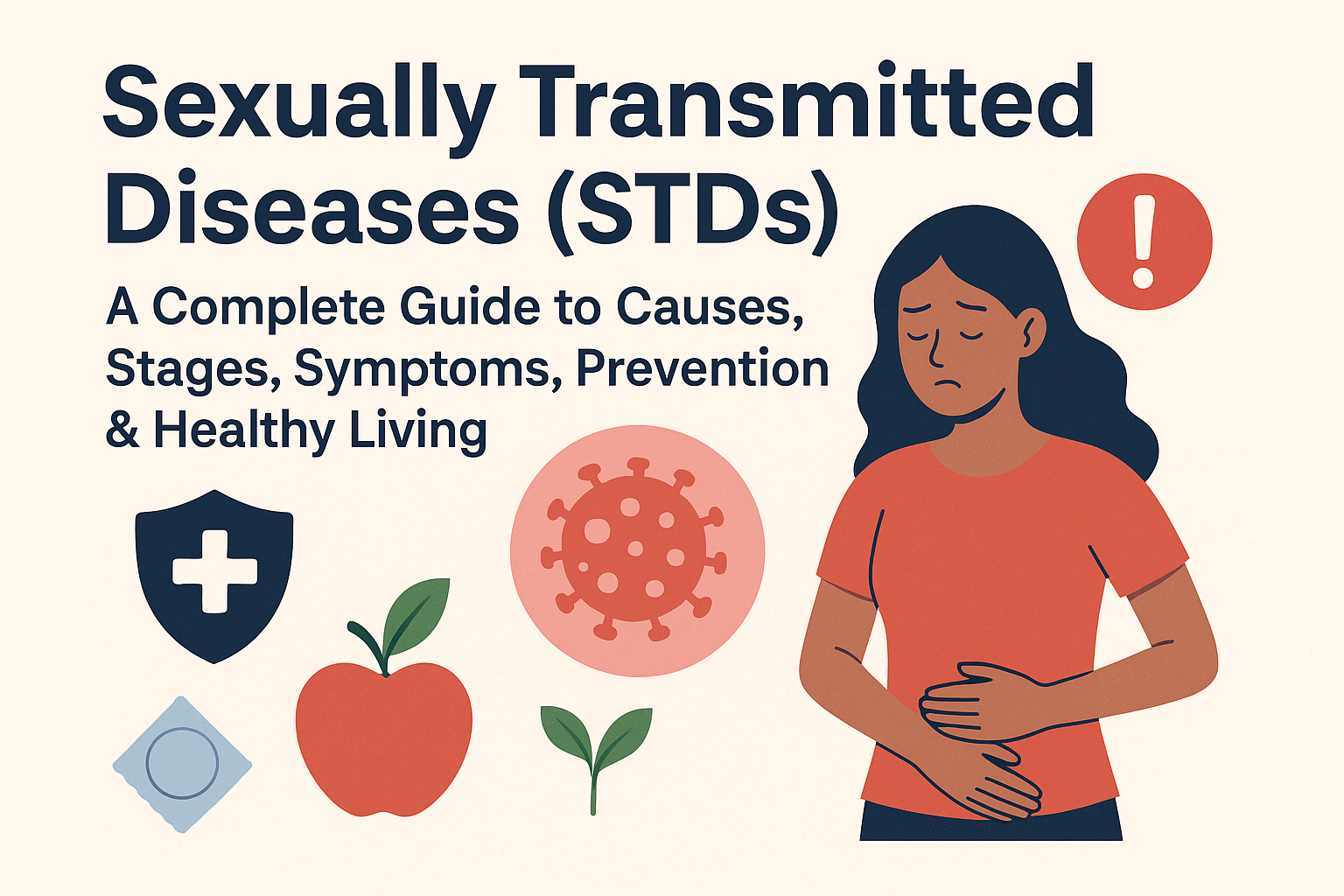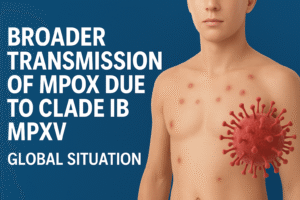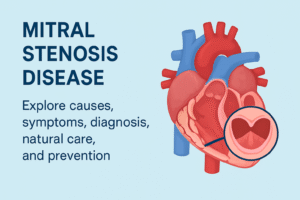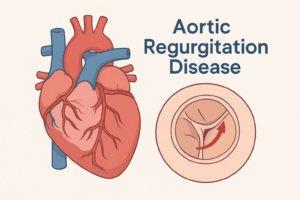Sexual health is one of the most important, yet often neglected, aspects of our overall well-being. One reason is the taboo around discussing it openly. Despite progress in awareness, education, and medicine, sexually transmitted diseases (STDs)—also called sexually transmitted infections (STIs)—remain one of the biggest public health challenges globally.
According to the World Health Organization (WHO), more than 1 million new STIs are acquired every single day worldwide. Yet, most people hesitate to seek information or medical help due to fear, shame, or stigma. That silence only worsens the problem.
This guide will help you understand STDs in a clear, humanized, and practical way—covering causes, stages, symptoms, risk factors, treatment options, lifestyle support, prevention, diet tips, and even the emotional side of living with STDs.
What Are Sexually Transmitted Diseases?
STDs are infections transmitted mainly through sexual contact—whether vaginal, anal, or oral. But that’s not the only way; they can also spread through:
- Blood contact (via transfusions or shared needles)
- From mother to child during pregnancy or childbirth
- In rare cases, through skin-to-skin genital contact
Some common STDs include:
- HIV/AIDS
- Syphilis
- Gonorrhea
- Chlamydia
- Genital herpes
- HPV (human papillomavirus)
While many bacterial STDs are curable, viral ones like HIV or herpes can only be managed, not completely cured. If untreated, they can lead to infertility, chronic pain, pregnancy complications, or even life-threatening conditions.
Causes of STDs
STDs are caused by different infectious agents:
- Bacterial infections – e.g., Gonorrhea, Chlamydia, Syphilis
- Viral infections – e.g., HIV, Herpes, HPV, Hepatitis B
- Parasitic infections – e.g., Trichomoniasis, Pubic lice
- Fungal infections – Rare, but genital yeast infections may spread sexually
Transmission happens mostly due to unprotected sex, unsafe blood contact, or vertical transmission (mother to child).
Stages of STDs
Like most infections, STDs progress in stages if untreated:
- Incubation Stage – Silent period between infection and symptoms.
- Primary Stage – Early signs such as sores, discharge, or rash.
- Latent Stage – No visible symptoms, but infection remains active.
- Chronic/Complicated Stage – Long-term damage like infertility, cancer (HPV), organ damage (syphilis), or compromised immunity (HIV).
Knowing these stages helps with early detection and treatment before complications arise.
Common Symptoms of STDs
Symptoms vary widely, but here are common red flags:
- Unusual discharge from genitals
- Pain or burning sensation during urination
- Genital or oral sores, blisters, or warts
- Itching, irritation, or rashes
- Lower abdominal or pelvic pain
- Irregular bleeding (in women)
- Swollen lymph nodes, fever, or fatigue
Many STDs stay asymptomatic for years, which is why regular testing is essential for sexually active individuals.
Lifestyle & Natural Support (Alongside Medical Treatment)
While medical treatment is non-negotiable for bacterial and viral STDs, certain lifestyle practices can speed up recovery, reduce symptoms, and boost immunity:
1. Eat for Immunity
- Vitamin C foods: Oranges, bell peppers, papaya
- Zinc-rich foods: Pumpkin seeds, lentils, chickpeas
- Probiotics: Yogurt, kefir, kimchi for gut & vaginal health
2. Hydration & Detox
- Drink plenty of water, coconut water, and herbal teas like chamomile or green tea
3. Herbal & Natural Remedies (Supportive only)
- Garlic – antimicrobial properties
- Turmeric (curcumin) – anti-inflammatory
- Aloe vera gel – soothing for herpes sores
4. Stress Management
Stress often worsens herpes or HPV outbreaks. Try:
- Yoga
- Meditation
- Deep breathing
5. Hygiene & Self-Care
- Wear breathable cotton underwear
- Keep the genital area dry & clean
- Avoid harsh soaps or douching
Reminder: Natural remedies can support but never replace professional treatment. Always consult a doctor.
Prevention of STDs
The best approach is prevention. Here’s how you can protect yourself:
- Use condoms consistently (male or female)
- Get vaccinated against HPV & Hepatitis B
- Regular check-ups & screenings if sexually active
- Mutual monogamy with an uninfected partner
- Avoid sharing needles
- Have open conversations with your partner about sexual health
Risk Factors
Certain factors make individuals more vulnerable to STDs:
- Multiple sexual partners
- Unprotected sex
- Early sexual activity (before 18)
- Coexisting infections (e.g., HIV increases risk of others)
- Substance abuse (leading to unsafe sex)
- Lack of awareness or healthcare access
Global Impact of STDs
The numbers show why awareness matters:
- 1+ million new cases daily worldwide
- 374 million cases annually of just 4 STIs: chlamydia, gonorrhea, syphilis, and trichomoniasis
- HPV is the most common viral STD, linked to cervical cancer
- HIV/AIDS still affects millions, especially in developing nations
The impact isn’t just medical—it affects relationships, emotional well-being, fertility, and even economies through healthcare costs.
Healthy Diet for STD Recovery
Food plays a healing role. Focus on:
Immune Boosters: Citrus fruits, spinach, carrots, nuts, seeds, whole grains
Anti-inflammatory Foods: Salmon, olive oil, ginger, turmeric
Probiotics: Yogurt, kefir, sauerkraut
Hydration: Water, coconut water, herbal teas
Avoid: Processed sugar, alcohol, excess caffeine, and fried foods (they weaken immunity).
Breaking the Stigma
One of the toughest parts of STDs is not the infection itself, but the stigma. Many delay testing or treatment out of shame and fear, which only worsens health outcomes.
Remember:
- STDs are infections, not moral judgments.
- Seeking help early saves health, fertility, and relationships.
- Talking openly about sexual health promotes a healthier, safer society.
Final Thoughts
STDs are preventable, manageable, and often curable. The keys are:
- Practicing safe sex
- Getting regular screenings
- Seeking medical help early
- Supporting your body with a healthy diet and stress-free lifestyle
Taking charge of your sexual health is more than self-care—it’s an act of responsibility towards yourself, your partner, and your community.
Stay aware, stay protected, and break the silence around sexual health.







One thought on “Sexually Transmitted Diseases (STDs): Causes, Symptoms & Prevention”